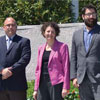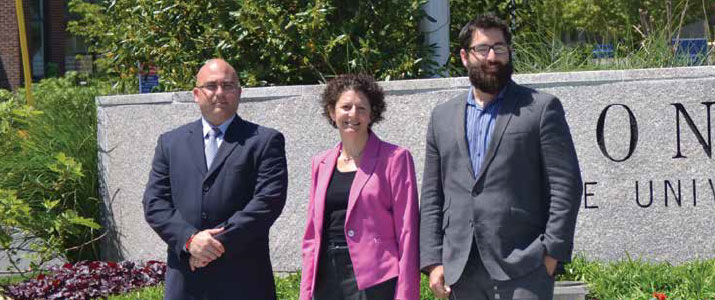
Regular Consultation
New York integrator sets security tone on higher education campus
- By Ralph C. Jensen
- Jul 01, 2014
 Jeffrey Sweeney wears multiple hats at A+ Technology and Security Solutions,
the highest profile of which is business development manager.
He also serves as a security consultant to various customers that sister
company, IPVideo Corp provides with security hardware. For Sweeney,
it’s the best of both worlds. He is an integrator and consultant with access
to IPVideo’s stable of networking solutions.
Jeffrey Sweeney wears multiple hats at A+ Technology and Security Solutions,
the highest profile of which is business development manager.
He also serves as a security consultant to various customers that sister
company, IPVideo Corp provides with security hardware. For Sweeney,
it’s the best of both worlds. He is an integrator and consultant with access
to IPVideo’s stable of networking solutions.
For A+ Technology, higher education is a main player in the security industry,
including Stony Brook University (SBU) on Long Island. It is part of
the State University of New York higher education system, including its worldrenowned
university medical center. From its beginnings a half century ago,
SBU has been characterized by innovation, energy and progress that includes
state-of-the-art security systems to protect students, staff and instructors,
while transforming the lives of people who earn degrees and those who make
groundbreaking discoveries in the university’s laboratories.
SBU has evolved in a dramatic trajectory of growth from what was once a
small teacher preparation college into an internationally-recognized research
institution. The university, however, is not too big to learn new lessons of its
own, which is perfect for A+ Technology, because when it comes to security,
there is plenty to learn.
A Pastoral Setting
Stony Brook’s reach extends from its 1,039-acre campus on Long Island’s North
Shore, encompassing the main academic areas, an 8,300-seat stadium and sports
complex, and Stony Brook Medicine to Stony Brook Manhattan, a research and
development park, four business incubators and various places where education
is a must. Stony Brook also co-manages Brookhaven National Laboratory
along with other such prestigious
names as Princeton, the University of
Chicago, Stanford and the University
of California, Berkeley.
Security is a must.
“We’re not just protecting an institution
of higher education, we
also protect a medical center and
always-growing research facilities
that have unique demands for security,”
said Lawrence M. Zacarese, assistant
chief of police and director of
the office of emergency management
at Stony Brook. “We are responsible
for more than 200 buildings, and all
that goes along with that. Our police
force is about 150 strong with 75 of
those officers acting as sworn officers
of the state. We provide security
in the medical center; and the staff
there face distinct challenges in that
environment.”
Stony Brook is still growing. There
are about 24,500 students; 11,500 are
residents on campus, and 24,500 staff
serve in various roles of education or
support. The university is a rather
large city in terms of land mass and
population, and it even has its own
911 call center, handling 38,000 calls
per year. Keeping everything on the
network operating properly is exactly
what keeps the university onsite
integration team busy.
“In our case, the higher education
campus is a public institution and
our goal is to make sure the security
staff on campus has everything
it needs to execute equipment to the
highest level,” Sweeney said. “While
the university has its own full service
integration team, we are the reseller
and trusted advisor, and when
it comes to new technology, we stay
ahead of the curve in an advisory
role to inform the customer what the
technology is used for and how it will
best serve them.”
More Cameras in Place
Because of its growth, Stony Brook
recently placed its 1,000th camera.
The university had been replacing
its old analog system with IP cameras
when there was a failure; though
in 2008, there was an internal decision
to use the latest technologies
and make the switch to an all-IP
system. That switch is ongoing and
when new cameras are warranted, IP
equipment is the choice. The cameras
of choice on this campus are Axis
and Panasonic.
The university poses an interesting
situation to campus police and to
A+ alike. For instance, the university
police use some of its annual budget
to upgrade and buy new cameras for
this campus. Other departments may
want to upgrade their own security
system so they, too, buy networking
cameras as well. Though it is a joint effort,
Zacarese and his staff are always
in the mix when it comes to security.
“Everyone on campus understands
IP cameras on the network
and how they work,” Zacarese said.
“With multiple buildings on campus,
everything is networked. The challenge,
of course, is that this is a public
campus and our challenge is to protect
the faculty, students and staff.”
“What really made our IP cameras
work was replacing the headend
servers and installing a friendly
video management system,” said Jack
Plunkett, chief technology officer at
IPVideo Corp. “We worked diligently
with A+ Technology and the university
by installing SentryVMS. This system has been very friendly to the university’s
efforts, and as they grow their security system, the
VMS will grow with us. It also is compatible with a
huge range of cameras, allowing us to use whatever
camera model makes the most sense in any given
location.”
The growth of security solutions has been steady.
In 2012, the hospital campus on the north side of the
university tapped into the same head-end servers.
All camera systems on campus are now converged,
feeding into the university’s command center.
The push for security has come from many
different avenues, not the least of which are concerned
parents, who want not only a good education
for their children but expect them to be safe
and secure in their learning environment.
Understanding the Software
The security system has been installed in such a
manner that adding to the security network is not
only simple, but can be completed rapidly and
without a hitch. Sweeney, who routinely visits with
the police department on security installs, said
that the campus can add 50 to 60 cameras at any
one time seamlessly, and the Sentry VMS head end
is completely expandable, with more than enough
room for growth.
“Our network engineers [A+ Technology] are
truly the backbone of our success at the university
because they understand the network, number
of cameras per server and where to place all the
equipment so it works at its optimum,” Sweeney
said. “We may not do the installs on campus, but
we have the ability to instruct how things and
where things will work best while putting the system
in place. This is much more than a point-andshoot
experience. As security integrators, we fully
understand how to maximize the view of a camera.
We understand how a building is built and how security
fits into today’s technology.”
Zacarese also said that the university has “lots
of real estate on campus” and is able to be an integral
part of the Emergency Operations Centers.
The university is seen as an inextricable unit
among all of it local, state and federal partners.
They have a place at the table when there is a regional
emergency and will be called upon to help
and serve.
“We are very fortunate to have an open line of
communication to A+ Technology,” Zacarese said.
“They support us in all our needs, lend expertise
and we work with them in understanding the potential
of new products.”
Embracing the IP Network
Zacarese said that his first encounter with security
on campus was not a pleasant experience.
The campus was filled with analog systems, and
even then, they were dispersed in a hodgepodge
manner. He also found DVRs located in ceilings
and sometimes in desks; nothing really seemed
to make sense. That’s when Zacarese touched
base with A+ Technology and Sweeney to begin a
phase-in implementation of the IP solution.
“A+ Technology helped us initially with servers
and a camera system,” Zacarese said. “We also applied
for and received a grant from the government
because we had a series laptops thefts that contained
sensitive research information.
“The analog cameras had no clear guidelines
established for their use. When we began to switch
over to the IP camera system, we implemented specific
rules for the use of the cameras and how they
should be used. For instance, the chemistry department
bought their own cameras, but it is our
responsibility to install and monitor how they are
used. The university bought the camera system for
the center mall of the campus, and again, we are responsible
for placing them and implementing them
to the best possible situation.”
The university also has invested heavily in an IP
camera system that benefits students from a recreation
standpoint. With the help of A+ Technology,
campus police have designed a security system
for the campus recreation fields where intramural
sports take place. Still at the heart, or head, of the
system is IPVideo’s SentryVMS, which brings all security
systems on campus together.
“Our success is working hand-in-hand with A+
Technology and implementing the VMS and hardware
they bring to the table,” Zacarese said. “They
know their hardware and how the software works
in concert. Let’s face it, on the university campus,
we have high-level, technical end users who want
and expect the best solution available.”
The switch to IP cameras has been a successful
adventure. Not too long ago, there were a few
burglaries on campus, just the same as any small
city might have. Within 24 hours, the subject was
identified and arrested. The security system provided
clear evidence as to who that person was in
every instance. The cameras caught the perpetrator
entering the campus, and eventually showed it
was a local high school student.
“The integration to IP cameras has certainly
helped our investigations,” Zacarese said. “We
know the technology costs money but we’ve been
able to get the money we need to invest in the latest
technology, and we get results.”
College campuses, however, have some unique
situations. Zacarese said that students often leave
doors open or unlocked, meaning there are crimes
of opportunity. He said that with a great security
system in place, campus police are able to move
quickly past an unlocked door to solve a crime.
Campuses, especially Stony Brook, are also filled
with research laboratories, and these offices house
information that must be secure.
“The good guys and the bad guys know there
is critical information here, and it is our responsibility
to help secure it,” Zacarese said. “Additional
security is used, which may be an iris scanner or
additional card access. With help from A+ Technology,
we are able to install what is needed and
warranted.
“Our campus police are really on a physical security
mission here. We behave within a culture
of security. We know this, and our partner, A+
Technology, knows this too.”
This article originally appeared in the July 2014 issue of Security Today.